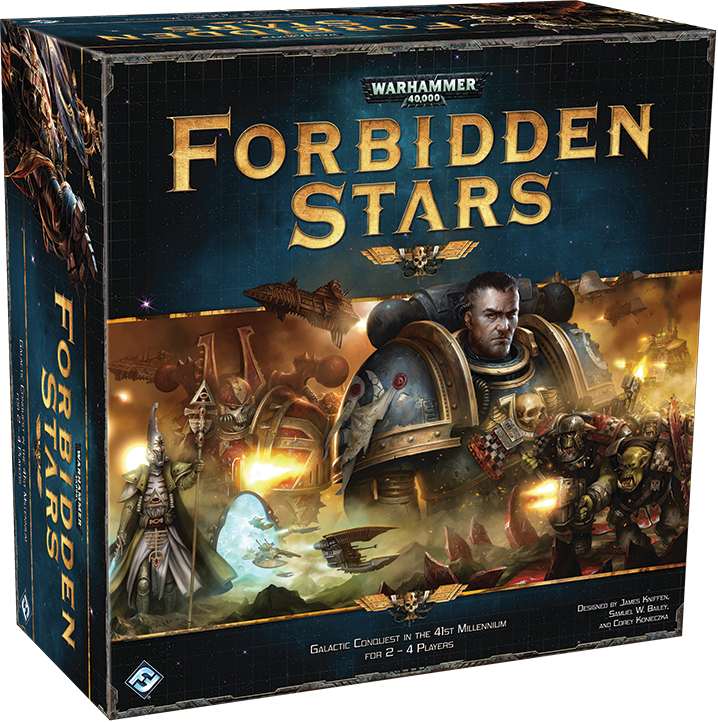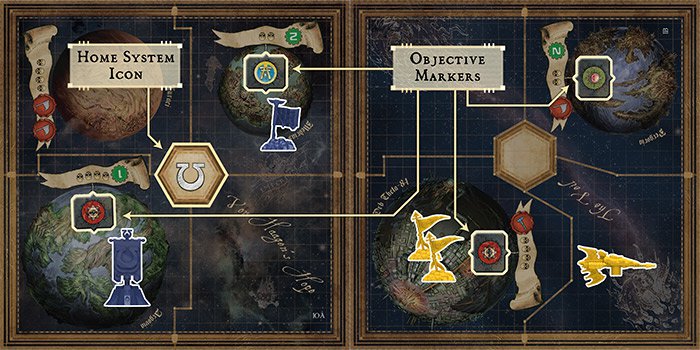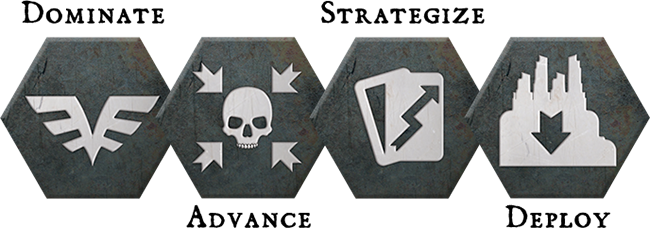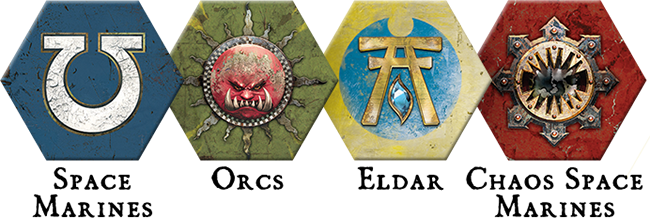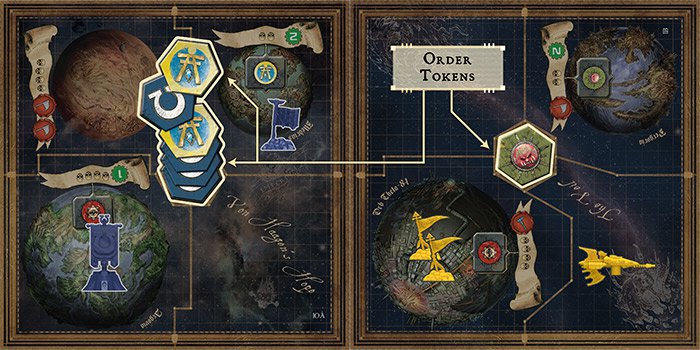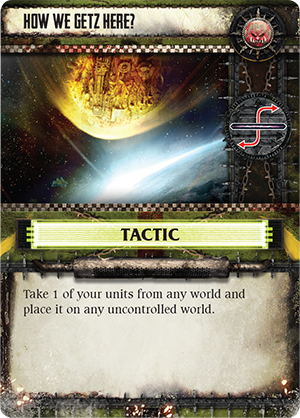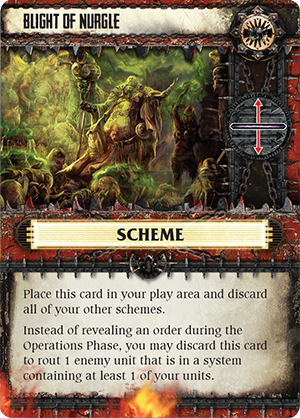Conquer the Grimdark – FFG’s Forbidden Stars


FFG pulls the covers off their upcoming game of space conquest in the Warhammer 40,000 universe. Take a look at this:
For countless centuries the Herakon Cluster could not be reached. Besieged by Warp Storms, its once-legendary natural resources, ancient artifacts, and growing populations became the stuff of myth, treasures dreamt of by man and xenos alike. Now, at last, the Warp Storms have calmed just enough to permit travel to the Herakon Cluster. Armies of Eldar, Orks, Chaos, and the Imperium are storming the sector, occupying whatever planets they can.
In Forbidden Stars, these factions battle to subjugate their rivals and reap the Herakon Cluster’s legendary wealth, turning the sector red with the flames of war and freshly-spilt blood in the process. Two to four players each command a faction from the initial occupation of the sector to the final, brutal battle for supremacy. Today’s preview takes you from the moment the Herakon Cluster opens up through the end of the first round and reveals how you can begin executing your strategies even before issuing the first orders.
Creating the Herakon Cluster
You and your opponents together create and occupy the Herakon Cluster from twelve unique, double-sided star system tiles. Taking turns, you place a star system, decide whether to station any units on its planets or ships in its voids, and place two of your opponents’ objectives in the system, until the whole sector is formed.
Strategic opportunities abound in this process.You could place your home system in an isolated and defensible corner to ensure security as you develop your military might, or nearer to the sector’s center, so all your objectives are within close reach.You could choose to juxtapose two planets, enabling your ground forces to move easily between systems, or hinder your opponents’ travel by setting planets next to voids. You could position your forces to immediately seize an objective in the first round, to reap useful assets from several worlds, or to destroy an enemy installation. Above all, you must take care to place your opponents’ objectives where they will be the most difficult for them to claim– far away from their home systems and deep in enemy territory.
Here, the Space Marines player begins the game by establishing his home system. He places Eldar and Chaos objectives within it, provoking those factions to attack him. The Eldar player next places a tile and establishes a nearby military presence, clearly planning to assault the Space Marines’ system early on. Not wanting to make things too easy for the Space Marines, the Eldar player places Ork and Chaos Space Marines objective tokens in her territory.
The last step in creating the Herakon Cluster is placing Warp Storms between systems. Nothing can move through a Warp Storm, so here you have the chance to shut an opponent in their own territory, prevent someone from quickly claiming an objective, or temporarily protect one of your occupied systems from attack.
Secret Orders in the Fog of War
With the Herakon Cluster’s expanses laid before you, your enemies’ positions known, and your faction’s objectives clear, you issue your first orders. You have four orders to choose from: you can strategize and upgrade your combat cards, dominate a system that you occupy to harvest assets from it, deploy to purchase new units, ships, and structures, or advance your forces into another system and attack. Future previews will discuss each order in detail.
Each player issues four secret orders per round, placing order tokens facedown in the system where they will take effect. Advance orders must be placed in the destination system, and you can only issue an order twice. Order tokens often form stacks, and as players take turns executing their orders, the top order of a stack must be executed before those underneath it.
Other players know where your orders are issued but, until they are activated, not what those orders are. You are always determining your future moves from within the fog of war, guessing at your opponents’ actions. This nevertheless offers some advantages. You can place an order token in a nearby system as a feint, fooling your opponent into thinking you’ll attack, then choose not to execute that order. You might also purposefully place your token atop an opponent’s, so that they cannot execute that order until you first execute yours.
Here, the Space Marines player has placed four order tokens in his home system, suggesting that he is going to dominate, strategize, and/or deploy in order to develop his forces and resources this round. But at the top of the stack, the Eldar player has placed two of her order tokens. At least one is likely an advance order, indicating that she is going to attack him before he can build more units. Meanwhile, the Ork player’s token suggests that he intends to advance into the adjacent system and attempt to claim an objective during this round.
Schemes and Shifting Warp Storms
Once resources have been harvested, forces advanced, and battles fought, players draw the event cards that control how Warp Storms move. Events offer players surprise maneuvers, but you can only resolve an Event card’s text if you played the strategize order or chose not to execute an order that you placed. Events laballed “Tactic” occur when the card is drawn, and help position you better for the next round, while “Scheme” cards are kept to be played at a optimum moment in the future.
Depending on what the diagrams on the cards command, Warp Storms may rotate clockwise or counterclockwise, or slide vertically or horizontally. Each player chooses a Warp Storm to shift, and each Warp Storm can only be shifted once. A Warp Storm could be placed to protect units in a vulnerable position, or some players might conspire and move their Warp Storms to prevent a single opponent from claiming a nearby objective during the next round. Used cleverly, Warp Storms can be as powerful a weapon as any Combat card in your deck or unit in your army.
Prepare for War
Within a single round of Forbidden Stars, the wealth of an entire world can be reaped. Factories, cities and bastions can be built, armies and fleets mustered and deployed. Systems can be invaded and planets occupied, and legions can seize glorious victory or succumb to hideous death in battle as starships rain destruction down upon once-pristine worlds. Yet that is only the beginning of ruthless war to rule the Herakon Cluster.
Future previews will delve into each of the four orders, combat, and the game’s four powerful factions. Keep checking the Forbidden Stars page for more information about this game of unprecedented interplanetary war and domination.
I love the playing pieces that FFG is working into all of their 40K boardgames these days. Great stuff!

